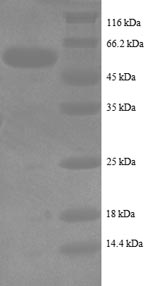Recombinant Human Intestinal-type alkaline phosphatase (ALPI) is produced in an E. coli expression system, covering amino acids 26 to 500. The protein carries an N-terminal 6xHis-tag for straightforward purification. It arrives with purity levels above 90%, as verified by SDS-PAGE analysis, which appears to support consistent performance in research applications. This product is designed strictly for research use and meets strict quality standards for endotoxin levels.
Intestinal-type alkaline phosphatase (ALPI) is an enzyme that's essential for dephosphorylation processes. It plays an important role in the digestive system by breaking down dietary phosphates. The enzyme participates in various physiological pathways, including nutrient absorption and gut barrier function. ALPI's activity seems vital for maintaining intestinal health and has become a subject of extensive research due to its regulatory roles in the human body.
Potential Applications
Note: The applications listed below are based on what we know about this protein's biological functions, published research, and experience from experts in the field. However, we haven't fully tested all of these applications ourselves yet. We'd recommend running some preliminary tests first to make sure they work for your specific research goals.
Human ALPI is a complex eukaryotic enzyme that requires precise folding, disulfide bond formation, dimerization, and glycosylation for its functional phosphatase activity. The E. coli expression system cannot provide the necessary eukaryotic post-translational modifications, proper disulfide bonding, or glycosylation required for ALPI's native conformation and enzymatic function. While the protein may be soluble, it is highly unlikely to achieve the correct folding needed for functional phosphatase activity.
1. Antibody Development and Validation
This recombinant ALPI serves as an excellent immunogen for generating antibodies against linear epitopes of human intestinal alkaline phosphatase. The partial sequence (26-500aa) provides substantial epitope coverage. The His-tag facilitates purification and immunization procedures. However, antibodies may not efficiently recognize conformational epitopes on the native, properly folded ALPI.
2. Biochemical Characterization
Basic biophysical characterization (SEC, CD spectroscopy) can assess physical properties, which provide critical data about the protein itself, not the native, properly folded ALPI.
3. Comparative Structural and Functional Studies
This protein can be used for sequence-based comparisons and immunological cross-reactivity studies with other alkaline phosphatase isoforms. However, comparative functional analyses would be invalid due to the protein's misfolded state. Structural comparisons via Western blotting are feasible, but functional comparisons are not.
Final Recommendation & Action Plan
The E. coli expression system is fundamentally unsuitable for producing a functional version of this complex eukaryotic enzyme, limiting applications to non-functional uses. The immediate priority is basic biophysical characterization to assess the protein's physical properties through SEC and CD spectroscopy. Application 1 (Antibody Development) can proceed immediately for generating linear epitope antibodies. Functional studies must be avoided due to the high probability of misfolding. For functional ALPI studies, alternative approaches using eukaryotic expression systems (e.g., mammalian or insect cells) that support proper disulfide bond formation, glycosylation, and dimerization are essential.






